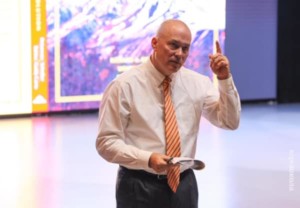Leading the Shift to Digital: School, System & City

We’re living through the most significant shift in how human beings learn—it’s bigger deal than the printing press and happening a lot faster. Almost everyone has a stake in the quality and speed of transition from the old model organized around birthdays and books to personal digital learning. In the near future, in cities and across networks that lead the shift, we could see a significant improvement in career readiness and economic participation.
As NGLC’s Andy Calkins explains, next generation learning will combine environments that blend the best of face-to-face and online learning with policies that allow students to progress as they demonstrate mastery. These environments better engage and prepare students while improving working conditions for teachers (see Improving Conditions and Careers).
This shift is inevitable; nearly all of our kids already live in the personal digital future. But it is not simple—at least not yet. Combining organizational design, technology integration, and large-scale change management is challenging and complex. The next gen toolset is a few years behind leaving a choice between manageable but disappointing platforms and a set of difficult to integrate components. Don’t get me wrong, there are already a million teachers helping kids experience powerful learning—it’s just hard to do it at scale in thoughtful progressions without better tools.
Fast or slow. If you’re a school or system head, you can influence the speed of the transition. Moving fast will boost student engagement and capitalize on the teacher leaders that have already transformed their classrooms, but it will require a more aggressive budget reallocations and stronger supports for teachers not equipped to move. A forward leaning community helps a lot.
By going slower, your school will benefit from better tools and pricing (the toolset get better every month) but you’ll notice growing pressure from stakeholders. By phasing the change over a longer period (or just allowing teachers to move at their own rate) you’ll introduce big inequities (i.e., why some kids have devices and others don’t) in your system that will be hard to explain.
Painting a picture of the future and putting it on a timeline are the two most important things a leader can do.
The vision thing. For the last year The Getting Smart team has been tracking 15 teams attempting to create next gen schools and we’ve made three observations:
- Next gen learning requires visionary and collaborative leadership. Whether fast or slow, it is imperative that leaders facilitate community conversations leading to a shared vision of personalized, blended, and competency-based learning. Field trips are the best possible learning experience; in most cases videos and school profiles will need to do. Leaders need to make the case for how the future will be different and better.
- Next gen learning requires strong management skills. As outlined in the Blended Learning Implementation Guide, it’s time to make a plan. Starty by identifying teacher leaders and give them a full or partial rlease to support the transition. Focus on critical success factors. Have a backup plan (because what can go wrong probably will).
- Innovation is iterative. Maintain a clear vision, but work in stages. Stay flexible. Take advantage of emerging opportunities. Make and test hypotheses in short cycles. (See Personalized Learning Demands Lean, Blended, Interative Approach.)
Summit Public Schools, a Bay Area secondary network, is best example of all three (see a recent update). Mark Edward’s book, Every Child, Every Day documents the four year transformation in Mooresville, North Carolina.
It takes better and more relevant preparation to work in next gen environments. As noted in a recent paper, Preparing Teachers for Deeper Learning, teacher preparation and development should be personalized, blended, and competency-based. (We’re kicking off the sequel on how to best prepare leaders—suggestions welcome!)
Move a city. So you want to change a city? A two year investigation of what it takes to transform learning opportunities across a city suggests 7 keys to education and employment:
- Innovation Mindset: a combination of growth, maker and team mindset—from classroom to city;
- Sustained Leadership: building political capital to create a portfolio of options;
- Talent Development: preparing and developing great teachers, leaders, and edupreneurs;
- Collective Impact: partnerships and community engagements;
- Aligned Investments: aligned public and private investment;
- New Tools & Schools: incubation capacity for new tools schools and connecting teachers and technology; and
- Advocacy & policy: a supportive environment for schools and startups.
We’ve seen some great examples of cities that have dramatically improved learning opportunities—and it all starts with leadership. (For more on urban education leadership, watch for the Smart Cities book, out September 15.)
Great leaders build a web of distributed leadership inside and outside formal institutions of education; they sweat the details of execution; and implement innovations as a series of iterations—testing and improving as they learn. It’s hard work, but for the health of our cities—and our country—it’s the most important work anyone could do.







0 Comments
Leave a Comment
Your email address will not be published. All fields are required.